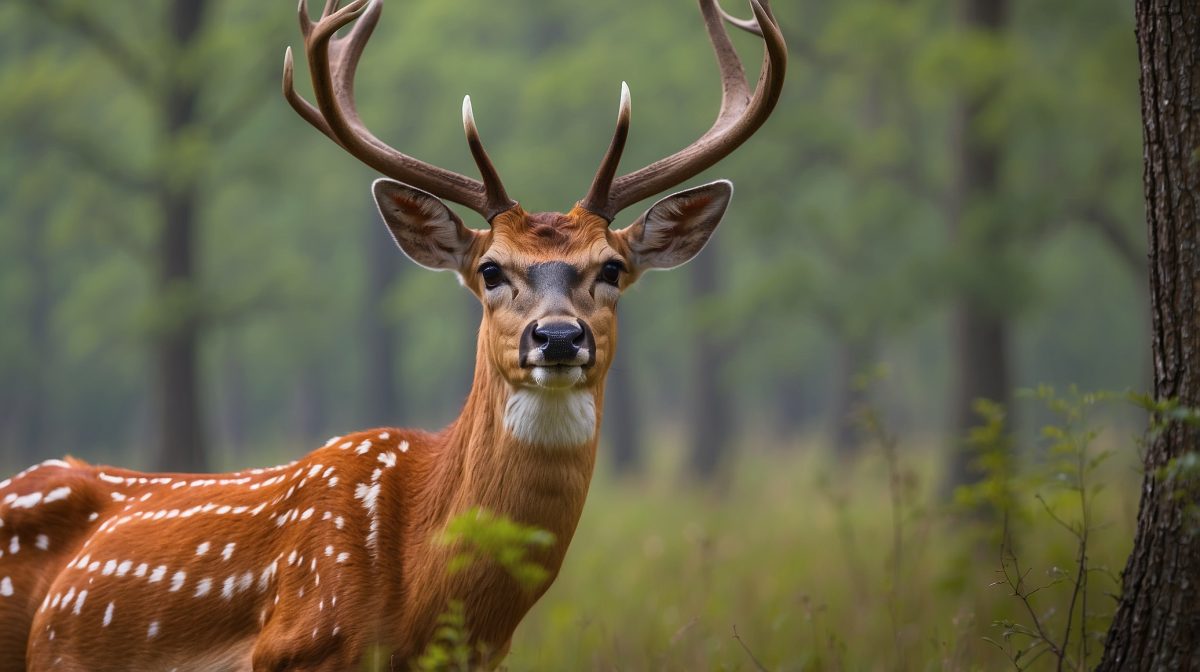Understanding Axis Deer Needs
When it comes to Axis deer, they’re a bit particular about where they lay their hooves. These critters prefer a mix of open land and forested areas, offering them the best of both worlds – room to roam and plenty of cover for restin’ and ruminatin’. They’re social animals, often seen in groups, and they’ve got a knack for adaptin’ to different terrains, which is why the Texas Hill Country suits ’em just fine. However, to keep these majestic animals thrivin’, we need to understand their behaviors and habitat preferences to cater to their needs properly.
Striking the right balance between open land and forested areas is crucial for the well-being of Axis deer. They need open spaces for grazing, but also dense cover to escape predators and harsh weather. Too much of either, and you’ll find these deer strugglin’ to survive. That’s why land management practices must aim to create an environment that mimics their natural habitat as closely as possible, ensuring these deer have access to what they need to thrive.
Habitat Management
Now, let’s talk about controlled burns. These are a vital tool for maintaining a healthy ecosystem for our Axis friends. By carefully settin’ small fires under controlled conditions, we can clear out invasive plant species that choke out the good forage and improve the health of native vegetation. This not only benefits the deer by providin’ them with better eatin’, but it also helps the whole ecosystem by reducin’ the risk of large, destructive wildfires.
When it comes to forest thinning, it’s all about improvin’ the quality of the habitat for the Axis deer. By selectively removin’ trees and shrubs, we can increase the amount of sunlight hittin’ the ground, which encourages the growth of plants that deer like to munch on. Thinnin’ also makes it easier for the deer to move around and spot any predators that might be lurkin’ about. It’s about creatin’ an environment where Axis deer can feed, frolic, and feel safe – all at the same time.
Supplemental Feeding Programs
Now, supplemental feedin’ can be a real game-changer for Axis deer, especially when Mother Nature is bein’ stingy with the rainfall. By providin’ the right type of feed and supplements, we can help these deer get through the tough times without a hitch. It’s important to choose feeds that are high in nutrition and mimic their natural diet as much as possible. But mind you, this ain’t about makin’ these deer dependent on handouts; it’s about givin’ ’em a helpin’ hand when they need it most.
Implementin’ the right feedin’ strategies is key to avoidin’ dependency among the Axis deer. It’s all about supplementin’ their diet in a way that encourages natural foraging behavior. This means distributin’ feed in a manner that mimics natural food sources and doin’ so at times when the deer would naturally be searchin’ for food. By doin’ this, we can support their nutritional needs without disruptin’ their innate behaviors.
Water Resource Management
Water is as precious as a cool breeze on a hot summer day, especially for Axis deer. These critters need a steady supply of water for drinkin’, and in the Texas Hill Country, that can sometimes be hard to come by. That’s why it’s essential to have reliable water sources scattered throughout their habitat. Whether it’s a natural stream or a man-made pond, these waterin’ holes can make a world of difference for the deer, particularly during droughts.
When we’re settin’ up water sources for Axis deer, we gotta think like a deer. The location is crucial – it needs to be easily accessible, but also safe from predators. Maintenance is another important aspect; we want to keep these water sources clean and full, to ensure the deer always have a place to quench their thirst. It’s one of the simplest, yet most impactful ways we can support these magnificent animals.
Responsible Hunting Practices
Selective harvestin’ is a part of responsible wildlife management and crucial for maintainin’ a healthy Axis deer population. By choosin’ which deer to take based on age, health, and population dynamics, hunters can help keep the herd strong and vibrant. It ain’t about takin’ the biggest buck every time; it’s about makin’ decisions that benefit the whole population. And remember, ethical hunting ain’t just good for the deer; it’s good for the land and the future of huntin’ in the Texas Hill Country.
When it comes to huntin’ season timin’, we’ve got to be mindful of the Axis deer’s breedin’ cycles. We don’t want to disrupt the natural order of things, so it’s important to schedule hunts at times that’ll minimize impact on the deer’s ability to reproduce and raise their young. It takes a bit of know-how and restraint, but by alignin’ our huntin’ practices with the deer’s life cycle, we can ensure that huntin’ contributes to conservation rather than hinderin’ it.
Fencing and Livestock Management
Fencin’ is more than just lines on a map; it’s about guidin’ and protectin’ our Axis deer. The right enclosure design can make all the difference, allowin’ for the free movement of deer while keepin’ ’em safe from dangers like busy roads. It’s about creatin’ barriers that serve their purpose without disruptin’ the natural patterns of wildlife. And when it comes to livestock, we gotta be good neighbors. Livestock and Axis deer can coexist peacefully, but it takes a bit of management to ensure they ain’t competin’ for the same resources.
Now, mitigatin’ competition for resources between livestock and Axis deer is all about balance. We’ve got to manage our grazing practices, so there’s enough to go around for everyone. Rotational grazin’ can help give the land a rest and allow vegetation to recover, which benefits both the livestock and the deer. It’s about sharin’ the bounty of the land without lettin’ one group hog it all.
Monitoring and Research
Keepin’ tabs on the health and growth of Axis deer populations is like readin’ the land – it tells you the story of how well your management practices are workin’. By trackin’ the deer through observation and technology, we can get a clear picture of their numbers, health, and habits. This ain’t just busywork; it’s crucial for makin’ informed decisions that’ll keep these deer prosperin’ for years to come.
Usin’ data to adjust management practices is where the rubber meets the road. It’s all about bein’ flexible and responsive to what the land and the deer are tellin’ us. If the numbers are dip, we might need to tweak our feedin’ strategies. If we’re seein’ too much brush encroachin’ on grazing areas, it might be time for another controlled burn. It’s a continuous loop of learnin’, adaptin’, and improvin’.
Community Involvement
Educating landowners and the public is a big part of keepin’ Axis deer numbers healthy. When folks understand the importance of these deer and the role they play in our ecosystem, they’re more likely to get on board with conservation efforts. It’s about spreadin’ the word and sharin’ our knowledge so that everyone can do their part in supportin’ these beautiful animals.
Collaboratin’ with conservation groups and wildlife experts is just good sense. It’s about poolin’ our resources and expertise to come up with the best strategies for Axis deer management. Together, we can tackle challenges that might be too big for any one of us to handle alone. It’s this spirit of cooperation that’ll ensure the Axis deer remain a proud symbol of the Texas Hill Country.
Conclusion
Now, we’ve covered a fair bit of ground today, talking about how to manage our lands to support them beautiful Axis deer. Remember, it’s all about respectin’ the land and the creatures that call it home. By implementin’ these land management practices, we can ensure that the Axis deer population continues to flourish right here in the Texas Hill Country. It’s our duty and privilege to look after this part of God’s creation, and I reckon if we do it right, the rewards will be plain to see – healthy herds of Axis deer roaming free and living well.
FAQs
What makes Axis deer different from native Texas deer species?
Axis deer, also known as chital, hail from India and have a unique spotted coat, unlike our native white-tailed deer. They’re also known for their impressive antlers and their tendency to keep ’em year-round, which is quite different from the sheddin’ habits of native species.
How often should controlled burns be conducted for optimal results?
Controlled burns should be conducted every few years, dependin’ on the condition of the land and the vegetation. It’s a delicate balance that requires a good understanding of the ecosystem and the needs of the wildlife.
What are the risks of overfeeding Axis deer?
Overfeedin’ can lead to dependency, disrupt natural foraging habits, and even cause health issues for the deer. It’s important to use supplemental feeding judiciously to avoid these risks.
What should be considered when setting up water sources for deer?
When settin’ up water sources for deer, consider accessibility, safety from predators, and the ability to maintain a clean and reliable water supply throughout the year.
How can hunters determine the most ethical practices for Axis deer hunting?
Hunters can determine the most ethical practices by followin’ state regulations, adhering to selective harvesting principles, and huntin’ outside of the deer’s breedin’ seasons to ensure minimal impact on population growth.


